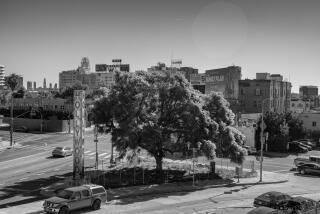Seeking Due Respect for Sacred Tree
CHRISTIANSTED, U.S. Virgin Islands â The gnarled branches of the 300-year-old Grove Place baobab tree have shaded labor meetings, childâs play--and less pleasant events.
In 1878, its branches were used to hang sugar cane workers who led an uprising against plantation owners on the island of St. Croix, when this American territory in the Caribbean was a Danish colony.
But these days garbage piles up around the huge tree, and the grass is overgrown and untended.
âI donât think people really understand the historical significance of the tree,â says Olasee Davis, an environmental scientist at the University of the Virgin Islands. âIt needs to be taken care of. It has not been getting the respect it deserves.â
Davis would like to see the tree in a neighborhood west of Christiansted protected as a historic landmark.
Nearly 60 feet in circumference, it is believed to have been planted with seeds brought by slaves from Africa, where some people believe the baobab is a sacred dwelling place of spirits.
Baobabs have a peculiar denuded appearance, which legend attributes to gods in a frivolous mood planting the trees upside down with their roots exposed to the sky.
Common in Africa, Madagascar and Australia, the baobab--also called the cream of tartar tree--briefly grows leaves in the wet season and produces large, white fragrant flowers that develop into oval gourds.
The kernels are eaten raw or roasted and are highly nutritious. Leaves and roots are used for medicine, the bark is made into string, rope and twine, and the gum can be used as glue.
Davis has been lobbying Virgin Islands senators to designate the Grove Place tree a historic site and to provide money for a sign and upkeep. No bill has been introduced yet, says Hectito Francis, a spokesman for the territoryâs legislature.
The idea of honoring the baobab appeals to people familiar with the tree.
As a girl growing up in Grove Place in the 1930s, Chrystalia Edney Parris remembers union meetings being held under the tree. She and her friends played with their dolls in the hollow trunk and joined in community gatherings in the shade of the tree.
âThe elderly people used to play âkaisoâ and dance under that tree,â she says, using an older word for calypso music. âThat tree is a landmark.â
Slaves likely brought baobab seeds to the Caribbean in an effort to maintain a spiritual connection to Africa, says John Rashford, an anthropologist at the College of Charleston who has studied the distribution of baobabs throughout the world. St. Croix has about 120 of the trees, more than any other Caribbean island, he says.
In the West African nation of Senegal, the baobabsâ large trunks have been used to contain the remains of elders. In other places, the trees are seen as aids to fertility.
But in the Caribbean, baobabs have taken on a more secular role.
âPeople have a very deep and emotional attachment to the trees,â Rashford says. âThe baobab has come to represent the landscape and people of Africa.â
More to Read
Sign up for Essential California
The most important California stories and recommendations in your inbox every morning.
You may occasionally receive promotional content from the Los Angeles Times.








